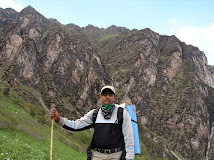In July 2010, I was visiting Western and Far-Western parts of Nepal (Nepalganj (Banke), Bardia, Kailali, Kanchenupur, Mahendranagar, Doti and Dadheldura) together with my two colleagues Mr Rabindra Parajuli and Mr Khem Kandel. The prime objective was to make study on different parameters (Sociological and Ecological) of Lichens. In Nepal lichens is called Jhyau, Tarey , Jhulo and Rai, Limbu and Sherpa people call it Yangben.
 |
| Everniastrum nepalense - Photo by Shiva Devkota |
Why the discussion on Lichens after almost a year? yes, its obvious. In coming January 9-13, 2012, I am attending International Licheonological Symposium, at Bankok and delivering paper on "Trade and Traditonal Knowledge of Lichens in Nepal Himalayas" together with my professor Prof. Christoph Schedeigger from WSL, Switzerland, under whose supervision I am doing PhD since last almost a year. My PhD is not related with this ethnic and trade concept, but in my last frequent visits in Sagarmatha (Everest), Manaslu, and Kanchenjunga (Olangchugola) I have collected sufficient information on ethnolichenology and trade patterns.
 |
| Heterodermia leucomila - Photo by Shiva Devkota |
While I am preparing my PowerPoint, and planning to prepare a research paper to submit in any of the ISI journal, I am getting excited with the realities behind the lichens in Nepal. Though it is called Jhyauu - infact it is much more important bio resource from the sociological and ecological aspects. In the name of management of lichens, there are many fragile rules and regulations in Nepal. So, pity is that, with the development of consensus among the players, sometimes government even lift the ban of lichen export. I am not saying that it is not good to harvest the lichens, but there must be some guidelines, stock estimation and market set up. The gap between real collectors and traders should be minimized for the equitable benefit sharing.
I was aware that, while I was in Nepalganj, my colleague SANAM introduced me with some traders, and provided a way to look their stores. Oh my God, store was with full of lichens and they were looking for the possibilities to send the lichens in India through illegal ways. Yaa, its common and every conservationists, every government staffs either from District Forest Offices of the respective districts or cadres of local level political parties - they all are aware about that.
 |
| Pure stand of Lobaria japonica, by SD |
Businessmans know very well, when the government is going to lift the ban. It is really a surprise, and later on same things will happen. It seems that they are a key to open the padlock of government in getting permission for the short time. Once they made export of all the lichens, then government used to ban the lichens. What a Pity??
The news published in Myrepublica.com might be interesting reading to you as well:
| Ban lift on lichen export unauthorized: CIAA | |
|
KATHMANDU, Sept 10: The Commission for the Investigation of Abuse of Authority (CIAA) has concluded that the decision taken by former Forest Minister Bhanu Bhakta Joshi to lift the ban on export of lichen worth Rs 42. 5 million was unauthorized.
Minister Joshi, in his capacity as a caretaker minister had decided to export 170,000 kilograms of lichen flouting the provisions of a gazette that had banned lichen export.
“We seized important documents and found that ex-minister Joshi had taken the decision for personal benefit,” said CIAA Secretary Bhagwati Kafle.
The Ministry of Forest and Soil Conservation (MoFSC) had banned export of lichen a year ago by publishing a gazette following a study that highlighted the adverse effects on biodiversity of such reckless exports.
Minister Joshi had decided to lift the ban for six months despite objections from MoFSC officials. “As per our investigation, Minister Joshi had decided to lift the ban simply to serve his personal interests,” said another CIAA source, adding, “We didn´t find any genuine logic behind the decision.”
Lichen is a grey, green or yellow plant-like organism that grows on trees, rocks and walls and is used for manufacturing herbal medicines and colors. According to experts, the herb is sold for at least Rs 250 per kg in India and China.
“Minister Joshi had claimed that the poor can benefit if the lichen in question is exported,” said CIAA source, adding, “However, his arguments are not convincing. We found him instead of trying to take an advantage in the name of the poor.”
Smelling rat over the deal, the Ministry of Law and Justice (MoLJ) had rejected Minister Joshi´s proposal. Minister Joshi had forwarded his decision paper at MoLJ seeking the latter´s approval to publish his decision in a gazette.
As per the existing legal system, a minister needs to get the consent of the law ministry to publish his decision in a gazette and publish it before it gets implemented. | |
|
|
|





_Dolpa,+Nepal_Shiva+Devkota.jpg)






_Dolpa,+Nepal_Shiva+Devkota.jpg)





































